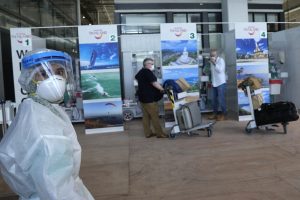Countries across Southeast Asia, targeting the year-end holidays, are taking cautious steps to reopen their borders as tourists with proof of COVID-19 vaccination join the mix of students, business travelers, and returning residents entering the region.
Earlier attempts to form travel bubbles between countries within and outside the region were scrapped after a surge in coronavirus infections from the Delta variant in July pushed health care systems to the brink, forcing borders to close once again to stop the deadly virus from spreading.
As countries report lower case counts and hospitalization rates from increased vaccination in recent months, governments from Jakarta to Hanoi are almost simultaneously, yet carefully, easing lockdown rules. Many are shifting their attention toward quarantine-free vaccinated travel lanes in hopes of reviving their COVID-battered economies.
Before the pandemic, travel and tourism contributed just over $380 billion or 12 percent of the collective GDP in Southeast Asia, according to estimates by the World Travel and Tourism Council.
Prolonged lockdowns could see the region lose up to 8.4 percent of its GDP in 2021, with the United Nations Conference on Trade and Development (UNCTAD), in a report published in June, projecting Southeast Asia’s inbound tourist expenditure to drop 82 percent this year.
In Thailand, where tourism contributed nearly 18 percent of GDP thanks to almost 40 million international tourists in 2019, government data showed that the country received only 6.9 million international arrivals in the first 10 months of 2020, largely from mainland China (1.2 million).
The Tourism Authority of Thailand expects tourism to take further hits in 2021 as cross-border travel remains restricted, with international arrivals projected to hit an all-time low of 1 million. Thailand’s Phuket Sandbox program, which began on July 1, saw limited success in the first two months of its launch with just over 26,000 travelers visiting the Thai resort island, far below the 100,000 arrivals it hoped to achieve by the end of September.
However, many local tourism businesses are hopeful that the upcoming peak season from December to March would see new bookings come in. Thailand has since expanded its sandbox program to include other key destinations such as Bangkok, Krabi, and Phangnga opened to fully vaccinated foreign tourists from “any country in the world.”
In Indonesia, several islands, including Bali, opened up on October 14. Indonesia has been among the countries worst hit by COVID-19 in Asia, officially recording more than 4 million cases and 144,000 deaths.
Southeast Asia’s largest economy was previously the epicenter for the pandemic in Asia, overtaking India in July. However, daily cases have fallen from over 56,000 at the peak of the second wave in mid-July to fewer than 360 cases on November 13.
Wealthy island nation Singapore expanded its quarantine-free travel lanes to 21 countries, with India, Indonesia, Qatar, Saudi Arabia, and the United Arab Emirates recently added to the list. The country is battling its worst outbreak yet, with daily infections hovering between 2,000 and 3,000 cases daily though 98 percent of its recent cases have either no or mild symptoms.
Across the causeway, neighboring Malaysia is also in the midst of extending its travel lanes to include Brunei and Doha in Qatar, after it inked deals with Singapore and Indonesia last week.
All countries in the region will be hoping that the reopening of borders can be sustained this time. Countries like Singapore, Cambodia, and Malaysia, which have among the highest fully vaccinated rates globally, have started administering booster shots for high-risk groups in hopes of reducing the chance of serious illness from the disease.
However, everywhere else in the region, vaccination rates remain low, with Vietnam, Laos as well as Indonesia and the Philippines – two of the most populous countries in Southeast Asia – all having vaccination rates of less than 40 percent, according to Our World in Data.
There is no doubt that Southeast Asia could experience another surge in COVID-19 infections, based on trends in the U.S. and Europe. The question is whether the region’s health care systems can cope in the event of another surge in coronavirus cases.
The administration of booster shots offers the most promising way to curb a Delta-led surge in cases, as vaccination remains the best way to protect against the coronavirus.
Other than that, countries should now have the capacity to ramp up their ICU capacity and have a stockpile of specialized equipment. In Singapore, its health ministry can ramp up ICU bed capacity to 1,000 from the current 380 ICU beds across all hospitals.
In Malaysia, the government recently ran a tabletop exercise involving health care workers and related agencies to simulate worst-case scenarios in preparation for a COVID-19 surge.
With training and emergency measures in place, countries can only hope that they have done enough to prepare when the next wave arrives. But for now, with Southeast Asia’s economies beginning to falter, the region must choose to reopen.

































